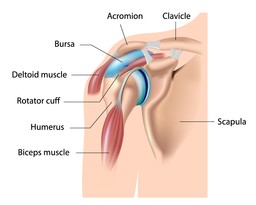

What is the shoulder?
The shoulder is made of three bones and two joints. The bones include the upper arm bone (humerus), shoulder blade (scapula), and collarbone (clavicle). The joints are made up of the ball and socket joint (glenohumeral joint) and the AC (acromiclavicular) joint where the clavicle and scapula articulate.
 The head of the upper arm bone fits into a rounded socket in the shoulder blade. This socket is called the glenoid. A combination of muscles and tendons help to keep your arm in this socket. These tissues are called the rotator cuff. They cover the head of the upper arm bone and attach it to the shoulder blade. There are several other muscles that are responsible for coordinated movement of the shoulder blade and neck which have an impact on moving your arm properly.
The head of the upper arm bone fits into a rounded socket in the shoulder blade. This socket is called the glenoid. A combination of muscles and tendons help to keep your arm in this socket. These tissues are called the rotator cuff. They cover the head of the upper arm bone and attach it to the shoulder blade. There are several other muscles that are responsible for coordinated movement of the shoulder blade and neck which have an impact on moving your arm properly.
What is a SLAP Tear?
A SLAP Tear is an injury to the labrum of the shoulder. The labrum is a cartilaginous ring around the rim of the socket (glenoid). SLAP stands for Superior, Labrum, Anterior and Posterior; meaning the upper portion of the labrum, front and back. This is the portion of the labrum injured.
Common Causes
SLAP tears can be caused by acute trauma or by repetitive lifting. Acute injury could include shoulder dislocation from a fall on an outstretched arm or in a motor vehicle accident. Repetitive overhead activities, in particular heavy lifting or ballistic activity (i.e. pitching), can also result in a SLAP lesion.
Symptoms
Similar to other shoulder problems, patients with this condition may experience shoulder pain or a decline in shoulder strength, as well as, a decrease in range of motion. Typically people report a feeling of “instability” and also experience popping and/or clicking. The shoulder may catch when performing overhead tasks, making it difficult to lower the arm.
Diagnosis
History and physical exam by a qualified musculoskeletal expert is the first step. X-ray or MRI scanning may be required depending on the mechanism of injury and symptoms. Examination of the shoulder will typically include palpation, observation, testing range of motion, strength and muscle length. In addition, various provocative tests may be used to target a particular structure. These will guide a clinician toward a proper diagnosis.
Treatment Options
There are surgical and non-surgical treatment options available.
Anti-Inflammatory medication drugs such as ibuprofen or naproxen could be prescribed to reduce pain and swelling. A qualified physical therapist could work with the patient on exercises that would return movement and strengthen the shoulder to regain range of motion, stability and strength. These shoulder exercises can prevent additional injury and relive pain. Cortisone injections may also be used to help decrease inflammation.
A common surgical procedure to treat SLAP Tears is arthroscopic surgery. During this procedure an arthroscope, or small camera, is inserted by an orthopedic surgeon into the shoulder joint. Images displayed by the camera on a television screen help to guide the surgical instruments used by the surgeon helping the surgeon best decide how to repair the torn labrum. The repair options will be determined by the type of tear, surgeon and the individual patient.
Rehabilitation
After surgery, a sling will be worn while the labrum heals keeping the shoulder somewhat immobilized because the repair needs to be protected. The length will be determined by the surgeon. A tailored physical therapy program will follow including phases of increasing range of motion and strengthening till it is appropriate to return to one’s prior activities without restriction.
Copyright © www.orthopaedics.win Bone Health All Rights Reserved